Waze is a social user-based GPS application which offers voice-guided navigation while also connecting you with other app-users. This allows you to receive real-time updates on traffic or road information. It can, for example give you a heads up on oncoming traffic jams or obstacles and provide alternative routes around them.
In 2013 Waze was bought by Google, enhancing the already extensive app with their expertise on geo-location (connecting it to Google Maps, Google+ & Google Earth) and more recently unlocking the possibility for business to advertise on the platform.
Waze started experimenting with advertising in 2014 in the United States and has more recently rolled out throughout Europe. Belgium is one of the most recent countries to be added to the list of countries where it is available.
Currently, Waze has over 200.000 active users in Belgium who drive around 400 km per month while using the app. This is a quite extensive user base which rises the question if there is a real business opportunity here.
Why advertise through Waze?
Waze is further riding the wave of hyperlocal advertising which has becomes one of the biggest trends of the past year. Hyperlocal advertising attempts to laser focus its messaging based on the user’s location. Through GPS data, customers receive messaging highly relevant to their current position. Combined with the flexibility of programmatic bidding, it allows advertisers to create a cost-effective strategy to engage its audience locally.
The most concrete example here would be national brand developing a strategy to promote their local stores. Through Waze people will only be notified of those shops closest to them or on the way of their daily commute.
While this is nothing new in the world of local advertising (e.g. Facebook allows you to target an audience in specific zones of around a 1 miles radius, or provides local-awareness ads that show ads when people are nearby your store) the extra benefit of Waze lies in its interface. Through the map and GPS functionality, users not only receive messaging highly relevant to their current location, they are also directly incentivized to drive to the location which is advertised.
How to advertise through Waze
Waze offers a myriad of different advertising possibilities which are targeted towards different business goals:
Create awareness of your brand
Waze can act as a ‘virtual’ billboard for your physical location through two of its formats:
● Branded Pin
This pin is a little icon of your logo. It will show up on the Waze map when a user drives close to one of your locations. If the user taps the pin a banner reveals itself with more information provided by you (for example a current promotion) and a call to action to drive to the location. The user can also choice to only save your offer or location instead of driving to it (this is the case for all ad formats).
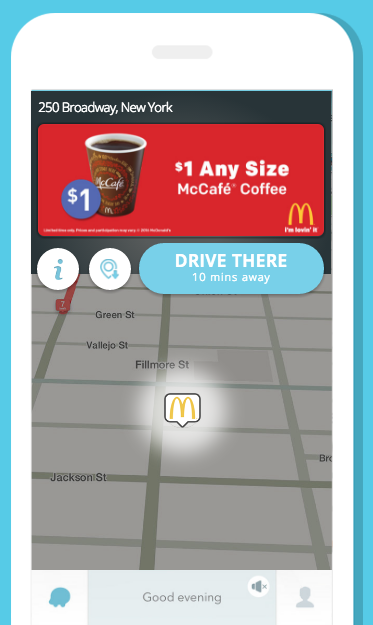
● Nearby Arrow
A few moments after starting up the app a signpost will appear pointing towards the directions of your business. This arrow will only show up if your location is relatively closeby (but not on the map). If the user clicks the arrow a banner shows up similarly to the one for the branded pins.
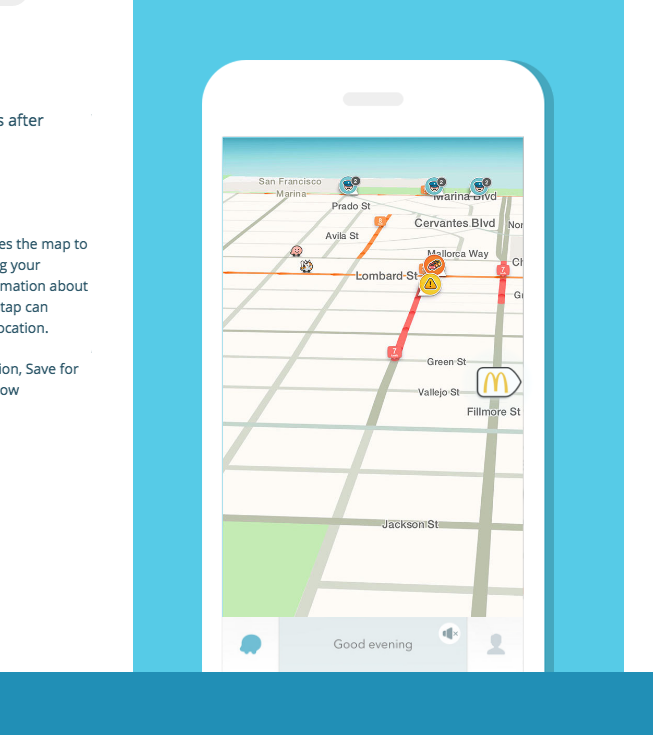
Drive traffic to your store locations
● Search Promotion
When users search for relevant brand and category terms your location will be eligible to show at the top of the search results. This ad will not only show your logo and the address, but can also include a specific call to action (like a promotion). The user can then press the search ad to start navigating towards the location.
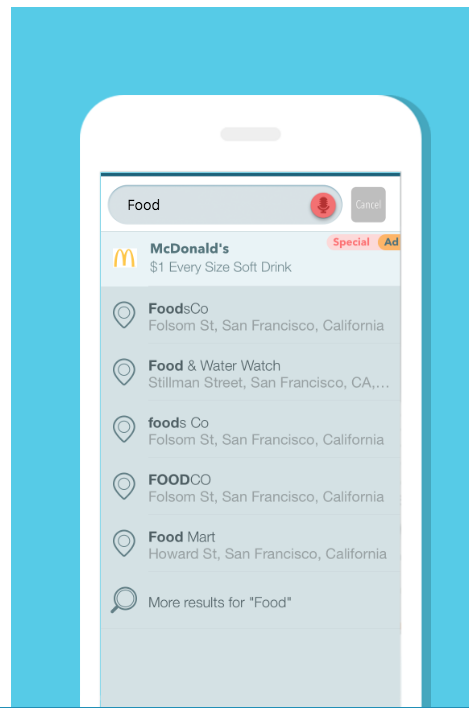
Promote actions
Next to the call-to-actions which can be included in search ads and the banner which is shown when users click on the pins waze also offers more direct ad formats to promote certain actions.
● Zero speed takeovers
When the app detects the user has been standing still for over 5 seconds it will display a pop-up canvas with a large visual. This is the most impacting ad formats Waze offers but also the most intrusive as it shows without any initial action for the users. This is why this type of ad only The shows up to 4 times per drive.
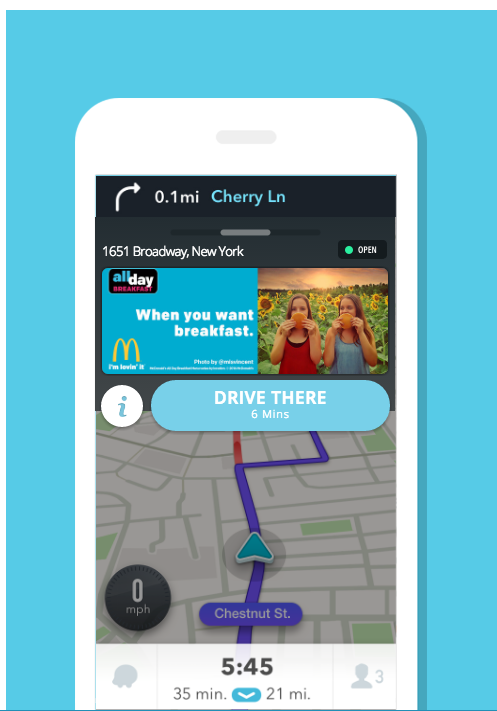
● Inbox Message
This message is immediately sent to the Waze user once he chooses to save your offer or locations and can provide complementary information.
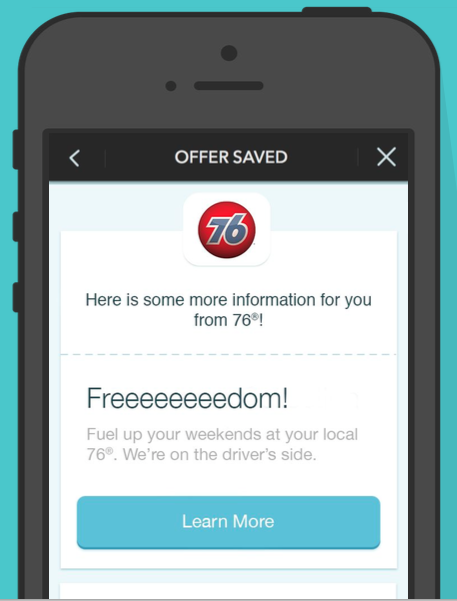
● Push notifications
This notification prompts the user towards the inbox message and will be triggered based on different parameters you can set (elapsed time, date, experation date of offer, proximity).
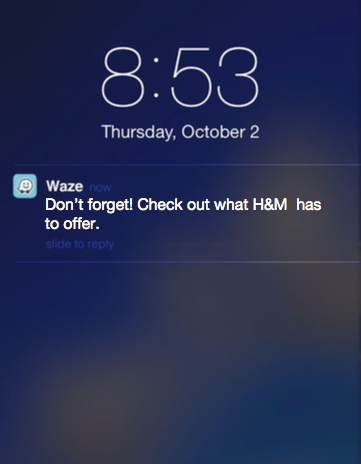
One of the most important thing to keep in mind while looking into these different ad formats is that all they only show up when the user is relatively close to the physical location which is advertised. There are also other targeting constraints you can set for your campaign including: weather, day of the week or time of day (for example only during opening hours).
Should I start using Waze to advertise my Business?
When you use the app in Belgium, you will see the occasional promoted pin starting to pop up or a search result marked ‘ad’ to appear when looking for the nearest place to get groceries back from work. Note here the word ‘occasional’: Currently only few brands are experimenting on the platform to see how it fits in their global-to-local strategy. This could benefit you in two ways: your business has more chance to be shown in on the map and in the search results and you will most likely not have to bid that high to get results. Waze works on a CPM basis and you can expect to be bidding between €1 and €2 CPM for your campaign.
While on the subject of campaigns and their investment, what is the minimal investment budget on Waze? Well this depends on the amount of business you will be promoting. For local businesses there is a minimal investment of €50 per campaign promoting one location (one branded pin) while brands will be looking at a 10k minimal investment for promotion of all their locations across Belgium with the different ad formats.
In the end it heavily depend on your industry and current strategy towards your physical locations. If your business offers products or a service which are often repeat purchases by people on the go (for example groceries or food) who would highly recommend to start up an initial test. Remember that it’s better to try, measure and iterate based on the result instead of waiting for your competition to get the head start.



